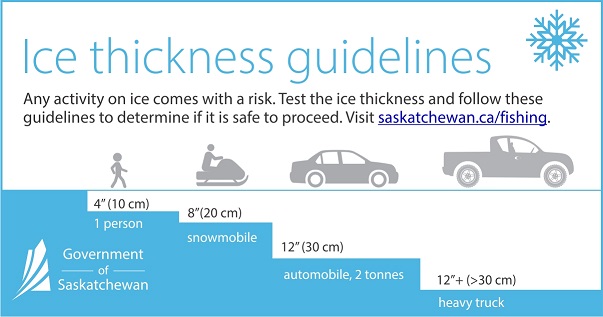Released on November 9, 2017
With recent colder temperatures across the province, the Government of Saskatchewan is reminding people to check for safe and sufficient ice before venturing out for ice fishing or other winter activities.
Ice thickness depends on the waterbody and surrounding conditions. Ice does not freeze at a uniform thickness and ice strength can vary considerably from one area to another.
Check the ice thickness before you travel on it. There should be at least 10 cm (4 inches) of ice to walk on, 20 cm (8 inches) to drive a snowmobile or ATV on, 30 cm (12 inches) to drive a car or light truck on, and more than 30 cm (12 inches) to drive a heavy truck on.
Any activity on ice comes with a risk. The ice thickness is a guideline for individuals to make a decision about whether to venture onto the ice. Ice thickness is just one factor to consider in ice safety. Clear, hard ice is the only ice recommended for travel.
Also avoid ice that:
- is slushy in appearance;
- has thawed then frozen again;
- is near moving water;
- is layered, caused by sudden temperature changes; and
- has structures on it, such as pressure ridges.
Visit www.saskatchewan.ca/fishing for more information in the 2017 Saskatchewan Anglers’ Guide.
The Water Security Agency is advising that reservoir water releases are occurring at both Rafferty and Alameda dams to draw the reservoirs down to their normal February 1 target level. These releases will delay the development of ice on the Souris River near Estevan and Oxbow, and Moose Mountain Creek below Alameda Dam.
-30-
For more information, contact:
Jamie Gibson
Environment
Regina
Phone: 306-798-3900
Email: jamie.gibson@gov.sk.ca
Patrick Boyle
Water Security Agency
Moose Jaw
Phone: 306-694-8914
Email: Patrick.Boyle@wsask.ca
Cell: 306-631-6997

